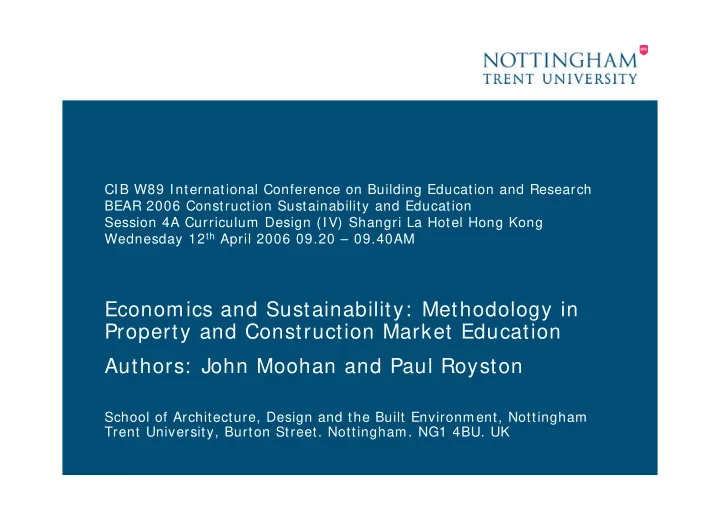

CIB W89 International Conference on Building Education and Research BEAR 2006 Construction Sustainability and Education Session 4A Curriculum Design (IV) Shangri La Hotel Hong Kong Wednesday 12 th April 2006 09.20 – 09.40AM Economics and Sustainability: Methodology in Property and Construction Market Education Authors: John Moohan and Paul Royston School of Architecture, Design and the Built Environment, Nottingham Trent University, Burton Street. Nottingham. NG1 4BU. UK
Aim and objectives • The aim is to elaborate alternative pedagogic philosophy and practice for the delivery of property and construction market education. • Principal objectives can be summarised as to: – Review relevant contemporary debates in economic methodology and thinking. – Critically appraise the paradigm of neo-classical economics in the context of the analysis and evaluation of property and construction markets. – Explain why a pluralist methodology would be beneficial in the analysis and evaluation of property market behaviour. – Illustrate the implications for pedagogic practice. 2 May 30, 2006
The neoclassical paradigm • Normative efficient market theory supported by econometric models has been the dominant academic approach in the pedagogy of property and construction market education. • But property and construction markets are not characterised by perfectly competitive market conditions. • Neo-classical models can have low explanatory and predictive powers where underestimation of property or construction risk occurs consequential to the use of historic valuation and cost data. 3 May 30, 2006
Post autistic economics and critical realism • The post autistic movement rejects a narrow focus on positivism and mathematical modelling in favour of a wider pluralist approach: – To what extent does a pluralist approach lead to greater understanding and explanation of property and construction markets? – To what extent should this be represented in the curriculum? • Lawson (1997) offers critical realism – a view that economics can be studied and applied scientifically whilst simultaneously rejecting the leadership and dominance of neo-classical economics. 4 May 30, 2006
Some comparative evaluation of neo- classical economics and critical realism • Neo-classical economics • Critical Realism – Deductive – Economic realities – Quantitative – Quantitative/ Qualitative – Epistemological – Ontological – Closed systems – Open systems – Events orientated – Events plus structures and measured through ‘facts’ powers matter – Observation and evidence – Aspects of reality may not based be observable – Tendency to equilibrium – Realities out of phase – Uni-directional transitive – Complex causal relationships relationships – Relationships stable – Relationships variable 5 May 30, 2006
A pluralist (heterodox) methodology in property and construction market education • A heterodox approach requires consideration of: – Critical realism. – Psychology and behavioural judgement and decision making. – Naturalistic decision-making. – Neo-classical models. – Neural networks. • .The naturalistic approach is appropriate where: – Problems are ill-structured and complex. – Information is ambiguous incomplete and changing. – Goals are ill-defined, shifting and competing. – Stress is high due to time requirements and/ or high stakes. – Decisions involve multiple participants as in sustainability. 6 May 30, 2006
The orthodox neo-classical approach in property and construction market education • Assumes the validity of a singular economic methodology. • Is highly deductive based on competitive markets and utility maximising behaviour. • A typical illustration based on CBA would be: – Description of the purpose and methodology of CBA. – Explanation of the processes of executing CBA. – Illustration of applications of CBA in the context of large scale development and construction projects. – Evaluation of the strengths and weaknesses of CBA. – Fitness for purpose issues and alternative approaches. 7 May 30, 2006
An alternative heterodox analytical, evaluative and creative pedagogic approach • Consideration of methodology is a first rather than a last resort for teaching staff, undergraduates and postgraduate students alike. • Economics in the Built Environment’ is replaced by multidisciplinary (possibly interdisciplinary) ‘Property and Construction Dynamics’. • Students are introduced to alternative paradigms in economics and related academic, managerial and professional approaches to market analysis and evaluation. 8 May 30, 2006
Illustration of pedagogic approach based on real or hypothetical case study • Detail a real world scenario with multiple stakeholders, ill-defined and changing goals, incomplete changing information, and uncertain start, duration and completion dates. • Form student project groups to act as consultants representing particular stakeholder interests. • Students select, apply and evaluate methods of appraisal consistent with stakeholder objectives. • Student presentations and assessment consistent with pre-defined criteria of assessment. 9 May 30, 2006
Conclusion • ‘Property and Construction Dynamics’ is a term for a pluralist approach to research and pedagogy relating to property and construction markets. • The dominant paradigm of neo-classical economics is replaced by a heterodox methodology. • Real world rationality and behaviour supersedes abstract utility maximisation, though the latter may be retained for benchmarking purposes. • The dynamics of property and construction markets is emerging but is not complete. 10 May 30, 2006
Recommend
More recommend